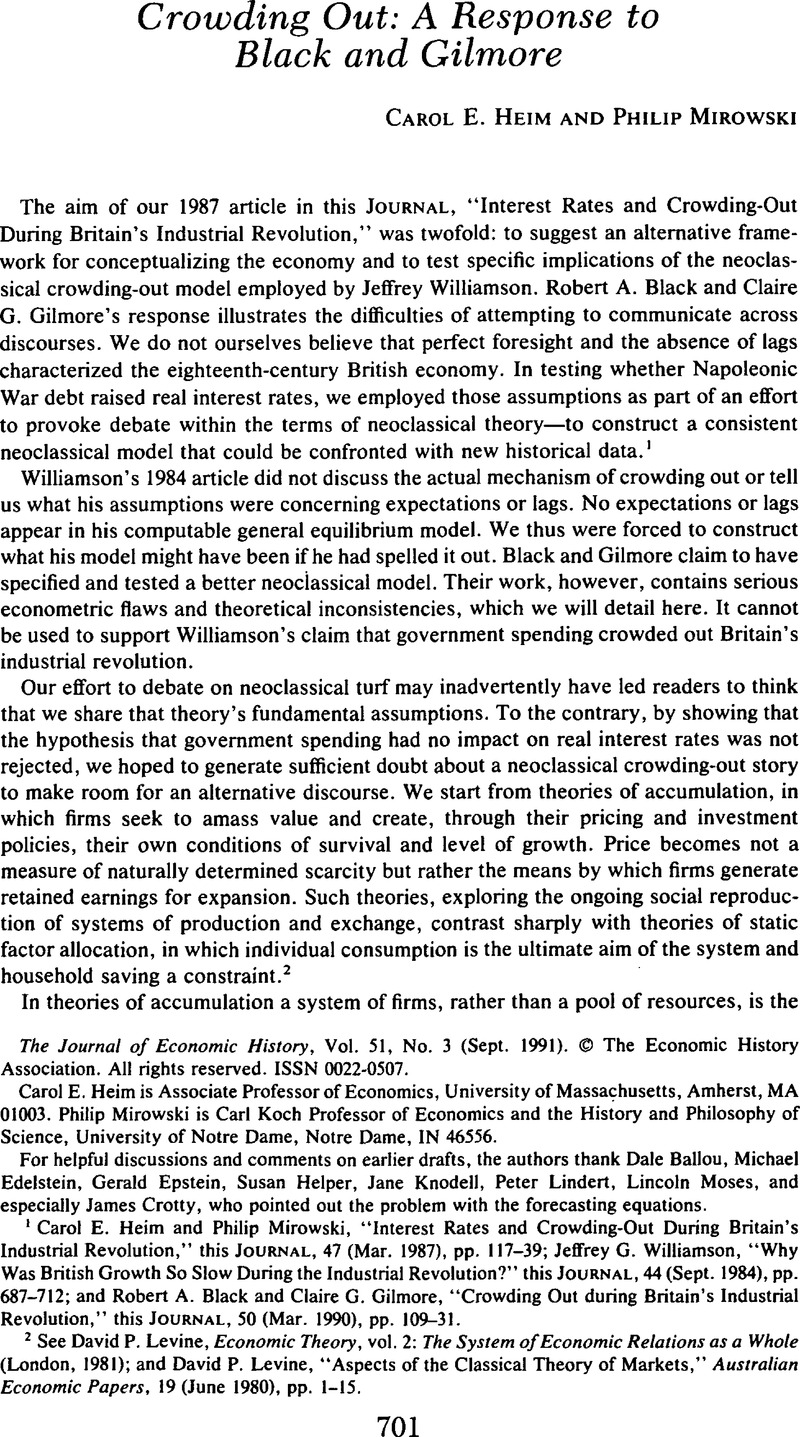Published online by Cambridge University Press: 03 March 2009

1 Heim, Carol E. and Mirowski, Philip, “Interest Rates and Crowding-Out During Britain's Industrial Revolution,” this JOURNAL, 47 (03 1987), pp. 117–39;Google ScholarWilliamson, Jeffrey G., “Why Was British Growth So Slow During the Industrial Revolution?” this JOURNAL, 44 (09 1984), pp. 627–712;Google Scholar and Black, Robert A. and Gilmore, Claire G., “Crowding Out during Britain'ss Industrial Revolution,” this JOURNAL, 50 (03 1990), pp. 109–31.Google Scholar
2 See Levine, David P., Economic Theory, vol. 2: The System of Economic Relations as a Whole (London, 1981);Google Scholar and Levine, David P., “Aspects of the Classical Theory of Markets,” Australian Economic Papers, 19 (06 1980), pp. 1–15.CrossRefGoogle Scholar
3 Hudson, Pat, The Genesis of Industrial Capital: A Study of the West Riding Wool Textile Indsutry c. 1750–1850 (Cambride, 1986).CrossRefGoogle Scholar
4 Barro, Robert J., “Government Spending, Interest Rates, Prices, and Budget Deficits in the United Kingdom, 1701–1918,” Journal of Monetary Economics, 20 (1987), pp. 221–47;CrossRefGoogle ScholarBrezis, Elise, “Did Foreign Capital Flows Finance the British Industrial Revoultion?” (Paper presented at the 1990 Climetrics Conference, University of teh Illinois at Urbana-Champaign);Google ScholarCrafts, N.F.R., “British Economic Growth, 1700–1850: Some Difficulties of Interpretation,” Explrations in Economic History, 24 (07, 1987), pp. 245–68;CrossRefGoogle Scholar and Mokyr, Joel, “Has the Industrial Revolution Been Crowded Out? Some Reflections on Crafts and Williamson,” Explotrations in Economic History, 24 (07, 1987), pp. 239–319.Google Scholar
5 Hudson, Pat, “The Regional Perspective,” in Hudson, Pat, ed., Regions and Inudstries: A Perspective on the Industrial Revolution (Cambridge, 1989);CrossRefGoogle ScholarMichie, R. C., The London and New York Stock Exchanges, 1850–1914 (London, 1987), p. 7;Google Scholar and Cottrell, P. L., Industrial Finance, 1830–1914: The Finance and Organization of English Manufacturing Industry (London, 1980), chaps. 1–2.Google Scholar On the regional character of industrialization, see also Pollard, S., Peaceful Conquest: The Industrialization of Europe, 1760–1970 (Oxford, 1981).Google Scholar
6 Neal, Larry, “Integration of International Capital Markets: Quantitative Evidence from the Eighteenth to Twentieth Centuries,” this JOURNAL, 45 (06 1985), pp. 219–26.Google Scholar Jeffrey Williamson argued that international capital market integration decreased during 1790–1820. See his “New Views on the Impact of the French Wars on Accumulation in Britain” (Harvard Institute for Economic Research Discussion Paper No. 1480, April 1990). This does not necessarily imply, of course, that London became more integrated with northern Britain as a result. On financing of the export trade, see Chapman, Stanley, The Rise of Merchant Banking (London, 1984).Google Scholar
7 Ray C. Fair and Robert J. Shiller recently stressed the importance of not incorporating future information into forecasts. See their “Comparing Information in Forecasts from Econometric Models,” American Economic Review, 80 (06 1990), pp. 375–89.Google Scholar
8 Darnell, Adrian C. and Lynne Evans, J., The Limits of Econometrics (Aldershot, Englad, 1990), chap. 4.Google Scholar
9 Clark, Peter, “Investment in the 1970's: Theory, Performance, and Predictin,” Bookings Papers, 1 (1979), pp. 73–113. Note also that the studies by Paul Evans, cited by Black and Gilmore in their footnote 23, showed that budget deficits do not raise interest rates—the exact opposite of what their footnote implies.CrossRefGoogle Scholar
10 Neal, Larry, “A Tale of Two Revolutions: International Capital Flows 1789–1819” (Bureau of Economic and Business Research Faculty Working Paper No. 90–1663, University of Illinois at Urbana-Champaign, 07 1990), pp. 21–24.Google Scholar
11 Black and Gilmore suggested (p. 123) that David Ricardo shared their view that wartime borrowing had a uniform tendency to raise interest rates. In fact Ricardo stressed the generalized disruption of the war years and its destabilizing effects on “the price of funded property” or rate of interest on government securities. See Ricardo, David, Collected Works, Sraffa, P., ed. (Cambridge, 1951), vol. 6, pp. 298–99.Google Scholar
12 See Mirowski, Philip, “What Do Markets Do?” Explorations in Economic History, 24 (04 1987), pp. 107–29.CrossRefGoogle Scholar